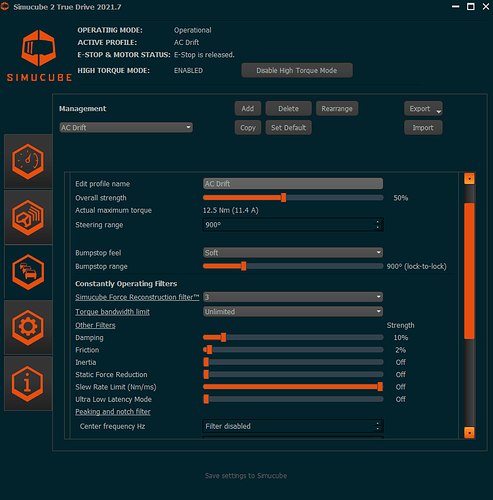Hello,
Been a long time! I still mostly love my SimuCube, but I have 2 issues that are currently annoying me a bit, so forgive if the text is a bit direct.
Issue 1
Back in 2019 I complained that the end stop force can’t exceed the “Overall Strength (Nm)” you set in your profile. This is still the case. In 2019 Mika replied:
“For some reason which I can’t remember anymore, the early Simucube 1 beta testers (before the first public release) said that there was indeed a notable difference in FFB smoothness when the final scaling step was changed so that it was done on the servo drive. However, it can be experimented with again for sure. If the final scaling is done before sending the value to the servo drive, and user uses for example 50% of the force, the resolution is reduced in half. On Simucube 2 Pro, this would be in steps of 1.5 mNm (millinewtonmeters). So, I really wonder if it really was placebo back then…”
Does that mean 16384 torque steps, at 25Nm result in 0.001526Nm step size?
And if you would run 5Nm, this again would become 16384 steps so a 0.000305Nm step size?
On a 30cm diameter wheel, the resolution at 25Nm would be a force of each hand of 2.5 gramms, 0.0025kg.
That is, per hand, the ‘weight’ of about 2 liters of air! It is really very tiny. I can’t believe anyone can feel this in a blind test. I think people passionate about their hobby easily over estimate their ability. (Audiophiles for example…)
PLEASE reconsider this, it really feels like such a letdown that the system, VERY capable, is hampered by not having an end stop when you prefer to run lower overall forces.
Issue 2
This is a bit harder to test, I tried to get Fedit (ffb test util from 1999) working but it isn’t happy on a modern system.
Game settings magically override the end stop set in the True Drive software.
I think maybe, the wheel is still accepting game forces when you’re in the end stop.
The logical behavior, in my mind anyway, is to fade out ALL the game stuff once you hit the end stop, and fade in the end stop. Soft/Medium/Hard can decide wether this fade angle is 10 or 20 or 40 or whatever degrees, but once in an end stop, stop listening to the game.
Slightly annoyed…
These 2 issues prevent me from enjoying some drifting I wanted to do with a power assisted low force car, but I can’t have end-stops this way, despite having an amazing FFB system that is definitely capable of doing this just fine! 
PLEASE consider looking at this again as I can’t see how any majority would see these issues as ‘desired behavior’… But maybe it is just me.
Video explaining / showing the issues:
